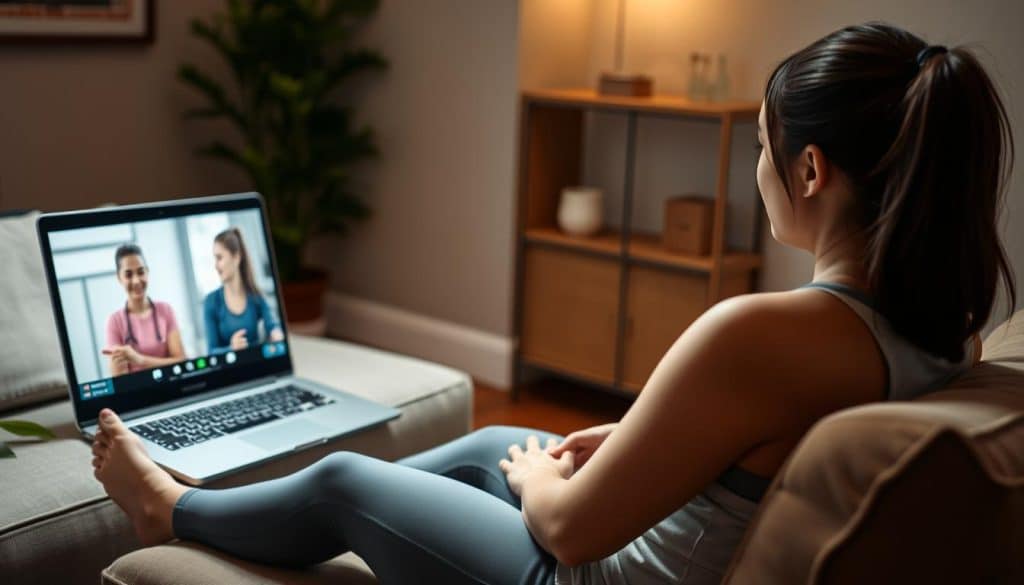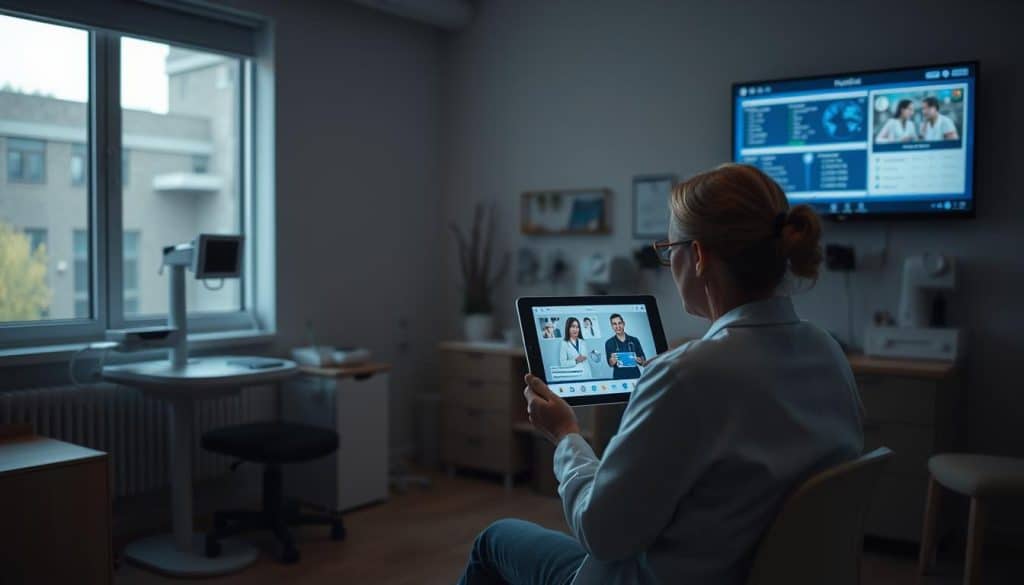New data reveals a 87% drop in virtual rehabilitation visits since 2020, creating urgent questions about quality care delivery. At Riverside Sports Therapy in Calgary, we’ve developed proven strategies to bridge this gap through specialized evaluation techniques.
Our team recognizes virtual care requires different approaches than face-to-face sessions. Through rigorous testing, we’ve identified key markers that predict successful outcomes – from movement analysis to patient-reported progress tracking. These insights help practitioners make informed decisions about care delivery formats.
Calgary’s active community deserves solutions that adapt to their needs. Whether you’re recovering from an injury or optimizing performance, understanding your options matters. Our framework combines real-time movement assessments with personalized feedback loops, ensuring no detail gets overlooked.
Key Takeaways
- Virtual rehabilitation visits fell sharply post-pandemic despite initial adoption
- Specialized evaluation techniques improve remote care quality
- Movement analysis and progress tracking are critical success factors
- Hybrid approaches work best for active lifestyles
- Patient-reported outcomes shape effective treatment plans
- Calgary-specific solutions address unique local needs
- Continuous improvement ensures evolving best practices
Located in the heart of Alberta, our Calgary-based team at (403) 283-7551 combines cutting-edge technology with clinical expertise. We help you navigate the changing landscape of care delivery while maintaining the highest standards – because your recovery shouldn’t depend on your location.
Introduction to Telehealth Assessments in Sports Therapy
Virtual care platforms became essential tools during global health challenges, transforming rehabilitation practices. At Riverside, we’ve refined these digital solutions to serve active individuals needing specialized support. Our Calgary-based team combines clinical expertise with innovative approaches to remote evaluations.

Telehealth assessments let practitioners analyze movement patterns and recovery progress through secure video connections. These virtual sessions work for initial consultations, exercise adjustments, and monitoring healing timelines. Key components include:
- Real-time feedback on technique
- Secure document sharing
- Progress tracking tools
The Center for Medicare and Medicaid Services’ 2020 policy changes opened new possibilities for remote care. We follow Alberta’s guidelines while using encrypted platforms that meet federal standards. Success depends on reliable internet connections and proper camera setups for accurate observations.
Physical therapy via digital channels requires different skills than in-clinic visits. Our staff completes specialized training to spot subtle movement changes on screen. Patients receive prep checklists to ensure productive sessions – from lighting tips to space requirements.
Rehabilitation through telehealth isn’t suitable for every situation, but it expands access for many. When used appropriately, this technology helps maintain continuity in recovery plans. The right approach balances convenience with clinical effectiveness.
Overview of Riverside Sports Therapy and Our Calgary Community
In the heart of Alberta, Riverside Sports Therapy bridges the gap between active lifestyles and accessible care through innovative approaches. Our Calgary-based team serves athletes and weekend enthusiasts alike, combining expertise with a deep understanding of local needs.
- Personalized recovery plans for injuries
- Performance optimization strategies
- Movement pattern analysis
Research shows over 50% of virtual care users live beyond county lines, facing transportation barriers. This data drives our hybrid model – blending in-clinic precision with remote support for those in surrounding areas. Harsh winters and busy schedules make flexible options essential for maintaining progress.
Our licensed specialists work with:
- Competitive athletes
- Recreational activity enthusiasts
- Youth sports participants
- Active seniors
Call us at (403) 283-7551 to discuss how we adapt our services to your location and goals. Through partnerships with local schools and organizations, we create networks that support both physical and virtual care delivery. This community-first mindset ensures solutions align with regional sports culture and healthcare needs.
Sports Therapy Telehealth Assessment Methods
At Riverside, our assessment framework combines technology with clinical expertise for reliable results. We prioritize structured protocols that adapt to your unique recovery goals while maintaining rigorous standards.

Your journey begins with secure digital forms that capture essential details about your condition and objectives. These tools help us identify patterns before your first virtual session, saving time and focusing on what matters most.
- Customized questionnaires measuring pain levels and functional abilities
- Video analysis of movement sequences like sit-to-stand transitions
- Timed home tests adjusted for safety and space limitations
- Decision pathways guiding next steps based on real-time data
Our team uses encrypted platforms to review your progress between appointments. You’ll receive clear instructions for setting up your space and devices beforehand, ensuring accurate observations during evaluations.
Documentation practices track both measurable improvements and qualitative feedback. This dual approach helps refine your plan as you heal, creating a responsive path to recovery that works with your schedule.
Transitioning from In-Person to Telehealth Visits in Calgary
Calgary residents now face new choices when managing their care journeys. While virtual options surged during pandemic restrictions, recent data shows only 0.9% of visits occurred remotely in 2021 as clinics reopened. Our team helps you navigate this shift through personalized support systems.

We start by evaluating whether remote care suits your situation. Factors like injury complexity and home setup determine eligibility. You’ll receive clear instructions about technology needs and session formats before beginning.
Key steps in our transition process include:
- Initial screening calls to discuss goals and resources
- Side-by-side comparisons of virtual vs clinic-based options
- Practice sessions with simplified exercises
Many find blended schedules work best – alternating between locations based on progress. This approach maintains hands-on care while building confidence in remote tools. Our team tracks comfort levels through quick check-ins and progress surveys.
Local challenges like winter travel or summer sports seasons often influence preferences. We adapt schedules accordingly, ensuring continuity whether you’re skiing at Canada Olympic Park or recovering at home. Flexibility remains central to our Calgary-focused model.
Your care plan evolves as needs change. Some return to clinic visits for specific treatments, while others prefer maintaining virtual check-ins. We prioritize what works for your lifestyle without compromising results.
Evaluating Patient Outcomes in Telehealth Visits
Understanding how virtual care impacts recovery journeys requires precise measurement tools. At Riverside, we combine standardized surveys with detailed demographic analysis to refine our approach continuously.
Patient Satisfaction Surveys
Our feedback system uses validated questionnaires measuring four key areas:
- Clarity of exercise instructions
- Ease of platform navigation
- Perceived progress toward goals
- Overall session value
Recent data shows 75% of virtual participants would recommend these visits, compared to 89% for in-clinic sessions. However, comfort levels and provider communication scored equally high across both formats.

Demographic Trends in Virtual Appointments
Analysis reveals distinct patterns among those choosing remote care:
- 68% live outside Calgary’s urban core
- 55% balance work commitments with recovery needs
- 42% prefer evening or weekend availability
Younger patients (18-35) adapt more quickly to digital platforms, while older adults value hybrid options blending virtual and in-person support. We adjust scheduling and communication styles based on these insights.
Your feedback directly shapes how we deliver care. Through quarterly reviews of survey data and demographic shifts, we identify opportunities to enhance accessibility while maintaining clinical rigor.
Benefits and Limitations of Telehealth in Sports Therapy
How does remote care measure up for athletes and active individuals? Our Calgary team sees clear advantages alongside specific scenarios where in-person visits remain essential. Let’s explore both sides using real-world insights from Alberta patients.

Remote sessions excel at maintaining consistency in recovery plans. You save hours previously spent commuting – especially valuable for rural Albertans or those managing work commitments. Research shows 78% of users stick better to treatment schedules when using virtual options.
Key strengths include:
- Reaching specialists across mountain towns and prairie communities
- Adapting to sudden schedule changes without cancellation fees
- Continuing rehab during blizzards or wildfire smoke advisories
However, certain situations demand hands-on attention. Complex joint assessments or precise muscle release techniques require physical presence. We always recommend hybrid plans for:
- Initial injury evaluations needing tactile feedback
- Sport-specific skill rebuilding phases
- Patients with limited tech experience
Your location and goals determine the right balance. While digital tools enhance accessibility, we never compromise on safety standards. Our team guides you through setup challenges, ensuring you reap telehealth’s rewards while addressing its boundaries head-on.
Telehealth Trends in the Post-COVID-19 Era
As the world moves beyond COVID-19, digital care adoption shows lasting changes in how people access support. While pandemic-era peaks have passed, our Calgary practice observes new patterns shaping recovery journeys. Patients now blend virtual and in-clinic options based on convenience and care complexity.
Hybrid models dominate modern approaches. Many choose video consultations for check-ins but prefer hands-on evaluations for new injuries. Rural residents and busy professionals maintain higher remote usage – 63% in these groups schedule monthly virtual visits alongside occasional clinic appointments.
Technology improvements help bridge quality gaps. Secure platforms now integrate wearable data and AI-assisted movement tracking. These tools let providers spot subtle changes during home exercises. Regulatory updates also influence adoption, with Alberta expanding coverage for certain digital services in 2023.
You’ll notice clearer expectations around virtual care quality. Patients demand high-definition video, instant document sharing, and measurable progress tracking. Our team addresses these needs through upgraded training and responsive feedback systems. The future lies in flexible solutions that respect your preferences while delivering results.
Ensuring Quality and Safety in Remote Therapy
Your trust in remote care starts with systems designed to protect and empower. At Riverside, we prioritize clear standards that keep you secure while delivering meaningful results. Every session follows strict guidelines developed through years of refining digital practices.
Technology Setup for Safe Evaluations
We begin by helping you create a safe space at home. Our team reviews room layouts to identify tripping risks and ensure stable surfaces for exercises. You’ll receive a checklist to remove hazards like loose rugs or poor lighting before sessions start.
Reliable tech forms the foundation of quality care. We verify camera angles show full-body movements and test audio clarity in advance. Backup communication plans keep you connected if signals drop during critical moments.
Your preparation matters. Detailed guides explain how to position devices and arrange furniture for accurate evaluations. We recommend involving a family member for complex movements, adding an extra layer of safety.
Emergency protocols are always ready. Staff train regularly to handle medical concerns or tech issues swiftly. Every adjustment made during sessions gets documented, maintaining clarity for your recovery journey.
